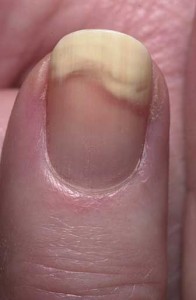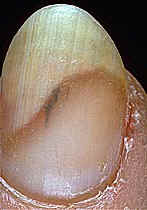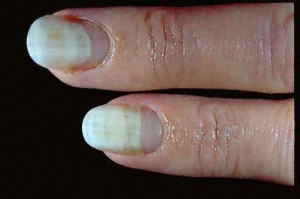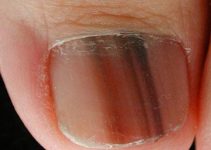Are your toenails coming out from the nail bed? You may be suffering from a condition called Onycholysis. Read on to get complete Onycholysis information. Know what is Onycholysis – its causes, symptoms, diagnosis, treatment and remedies.
Onycholysis Definition
Page Contents

Picture 1 – Onycholysis
Source – salongeek
Onycholysis is a common disorder affecting nails. The condition is marked by splitting of the nail bed, of the finger or the toe, from the nail plate. Usually, the nail plate remains attached to the nail bed. But this condition loosens the nail and it starts coming out from the nail bed. The nail starts taking the appearance of a half-moon and its free end begins to rise up like a hood.
Onycholysis can affect people of any age group and gender though it is more common in adults, especially females. It affects women more than men. One can see few cases of Onycholysis in children.
Onycholysis is also known by the name “Brittle Nails”.
The proper way of Onycholysis pronunciation is by spelling the condition as “Oni-koh-li-sis”.
Onycholysis Signs and Symptoms
Onycholysis is mainly characterized by the detachment of the nail plate of the finger or toe from the nail bed. The nail plate is the hard substance that covers and protects the top of the fingers and toes. When the nail starts coming off from the nail bed, the raised part looks white as there is only air between the bed and the nail.
Onycholysis of the nail can be quite discomforting and painful. Pain can be acute in cases of infection. An Onycholysis nail can impair activities and cause problems in walking and eating.
Is Onycholysis Infectious?
Onycholysis untreated can turn infectious. Over time, water, keratin debris, dirt and germ find their way under the nail inviting bacterial, fungal or yeast infection. The white nail Onycholysis appearance begins to appear yellow or creamy. In most cases Onycholysis causes infection. This can, however, be avoided with immediate treatment.
Unless treated in time, Onycholysis can give rise to abscesses in the nail bed. It may release pus from time to time. The entire region can pain for long.
Causes of Onycholysis
A number of factors can give rise to Onycholysis. Some of the common Onycholysis symptoms causes are
Trauma
Improper manicuring of the nails is often seen as a cause of Onycholysis. Over-trimming of the nails can expose the nail bed and may also result in lifting of the nail plate. In Onycholysis trauma of the nails is often the main cause.
Pressure
Wearing very tight-fitted shoes make the feet sweat and put the toenails under stress for a long time. This can lead to Onycholysis in toenails.
Hyperactive Thyroid
Over secretion of the thyroid glands can also result in Onycholysis.
Iron Deficiency
Deficiency of iron in the body can sometimes give rise to Onycholysis.
Skin Ailments
Skin problems like eczema and psoriasis can also act as causative factors of Onycholysis. The skin around the nail and cuticle turns dry and flaky in such cases.
Irritation
Exposure of the skin to an irritating substance can also give rise to Onycholysis problems in the nail. Certain chemicals in nail polish can be allergenic for the skin and produce harsh symptoms causing the nail to separate from the skin.
Moistening
In Onycholysis separation of the nail and nail bed can occur due to long exposure of the surrounding skin to water.
Medication
Onycholysis can also arise as a side-effect of certain medications. Tiny, white marks may appear on the nail as a result. In Onycholysis chemotherapy medications, Tetraycline drugs and medicines containing Vitamin A are often found to be causative factors.
Psoriasis
In Onycholysis Psoriasis is often a main cause. Psoriasis is a chronic skin disorder. When the disease affects skin of the fingers and toes, the nails can be seriously affected. In advanced stages, the entire nail can come off from the bed. Onycholysis in psoriatic fingernails can be quite difficult to treat.
Onycholysis Diagnosis
Onycholysis can be diagnosed by physical observation and also by lab examinations. An expert doctor detects the disorder simply by looking at the nails. In some cases, however, lab tests are required. A Dermatologist takes sample of the debris from under the nail and carries out a fungal culture or KOH Test on them. KOH Test helps in making a quick diagnosis of a nail infection in case of Onycholysis.
Treatment for Onycholysis
For people looking for recovery, Onycholysis treatment is quite simple. Here are some of the methods you can implement for Onycholysis cure.
Trim the Nail
It is better to carefully clip off the raised portion of the nail. Once the nail separates from the bed, it cannot reconnect with the skin. It is better to trim away the detached part of the nail and wait for the nail to grow back. This will also prevent foreign objects from settling under the raised nail plate and prevent onycholysis fungal, bacterial and yeast infections. Try not to expose the nail bed as this can make it more susceptible to infections.
Trimming nail is seen as an effective Onycholysis self treatment. Until the nail grows back, antibiotics, analgesics and other medications will help prevent other symptoms.
Avoid Harsh Chemicals
Avoid strong chemicals and products that can cause skin irritation in your nail bed. If you suspect your nail polish to be the factor, it is better that you stop using it. Use a nail polish remover to clear away all traces of cosmetic from your nail plate.
Keep Nails Short
Keeping nails long makes them more susceptible to injuries. It is better to keep nails short so that you do not have to encounter nail trauma in future. Even if you do not yet have Onycholysis toenail and fingernail shortening can help you avoid it in future.
Wear Loose Shoes
As aforesaid, tight-fitted shoes can injure nails and make the feet sweat unnecessarily. If you wear too tight shoes, switch to light, loose shoes that provide space to your toes. This will keep Onycholysis toe problems at bay. In Onycholysis stress on the nails should be avoided at all costs.
Avoid Water
Onycholysis yeast infection is often seen to attack people who stay in water for too long. If it is not possible for you to keep out of water for long, use skin-drying agents like Castellani’s paint. Apply a bit of this around the nails in fingers and toes to prevent infection.
In Onycholysis home treatments are usually enough to help sufferers get rid of the condition. But in infectious cases of Onycholysis home remedy should be accompanied with professional medical assistance. It is better that you consult a doctor in case of an infection.
Onycholysis and Thyroid Disease
Many factors can give rise to Onycholysis and Hyperthyroidism or Hypothyroidism is often seen as causes behind the appearance of this condition. These disorders make the nail brittle and lead to the separation of the plate from the nail bed.
Onycholysis Pictures
Want to know what does Onycholysis look like? Here are some useful Onycholysis images that will give you an idea about the appearance of the condition.

Picture 2 – Onycholysis Image
Source – footdoc.ca

Picture 3 – Onycholysis Photo
Source – uiowa.edu
If you have Onycholysis or have someone suffering from it in your family, it is advisable that you carry out the treatment at the earliest. Faster treatment will help a faster recovery from the condition and prevent al future complications.
References:
http://en.wikipedia.org/wiki/Onycholysis
http://www.wisegeek.com/what-is-onycholysis.htm
http://www.nailsmag.com/article/81928/what-is-onycholysis?Page=2
http://www.associatedcontent.com/article/5417942/onycholysis_nail_lifting_causes_symptoms.html
http://www.internationaleczema-psoriasisfoundation.org/nail_psoriasis.php4


I found the articles here very informative, simply explained so even hopefuly the elder can understand. However, under your treatment section I think you should be a little more specific that after they see their doctore, they may be referred to a specialist.
Thank you, and I will contine to use this site for references!
This is a really useful article. I sometimes see people with sick nails and they do not pay attention to it.